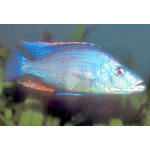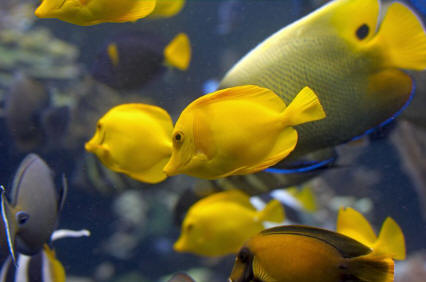Hap. compressicep 5 color

|
Scientific Name: Dimidiochromis compressiceps Price: Upon Request Origin: Africa - Lake Malawi Family: Cichlidae NOT AVAILABLE NOW |
|
Other Names: Malawi Eye Biter, Malawi Eyebiter, Eyebiter, Compressiceps, Haplochromis, Compressiceps |
|
Technical Info
Temperature: 23 - 28 ℃
pH: 7.8 - 8.2
GH: 10 - 15
Max size: 26 cm
Min Tank size: 300 Ltr
Position in Aqua: No special swimming level
Description
The unique physical aspects of the Dimidiochromis compressiceps makes it a favorite to some cichlid admirers. With a compressed, thin, yet deep body, these guys are adapted to very quick bursts of speed to catch their prey. The male is an almost metallic blue and sometimes green coloring, with an orange anal fin that has the typical egg pattern. The females are basically silver and the juveniles are light in color. All Malawi Eyebiters have a dark horizontal line down the middle of the body, extending from behind the eye to the base of the tail fin.
Food
The Malawi Eyebiter is an omnivore / piscivore with a large portion of their diet being small bony fish. They will kill and eat any fish that is smaller, and 1/2 its size for sure. It is not necessary to feed live feeder fish, which as with any cichlid will heighten aggression. They may be fed shellfish, shrimp, beefheart and some green veggies. They do need some vegetable matter to help prevent Malawi bloat. The babies can be fed mosquito larvae (blood worms), but need larger foods as they grow. They can also be given high quality protein based frozen cichlid food or pellets. A good diet along with vitamins will keep your Malawi Eyebiter in peek condition. Vary their diet and they will reward you with beautiful coloring. Some cichlids cannot eat beefheart, so keep this in mind when housing these with the Malawi Eyebiter.
Breeding
Males become very aggressive during spawning. The fish needs a good and varied diet to spawn. The female will brood for up to 4 weeks. You can tell if a female is brooding by her enlarged mouth and the fact that she isnít eating. Fry accepts most kinds of food. Brooding females can be isolated for more productive breeding. It is recommendable to try to make the isolation as short as possible to avoid that the females loses their social status which may cause fights once they are returned. Stress might cause the females to eat eggs and fry. In some cases the male is the course of stress that causes her to eat her fry. In that case its best to separate the female from the male during the next brooding season.
Compatible with
This fish is not considered to be a community fish. It is a predator but only moderately aggressive. However the Malawi Eyebiter is not considered a Mbuna, and will generally attack and kill the smaller Mbunas. They should not be kept with any Mbunas, but they can be kept with larger Peacock cichlids without incident. As long as the tankmates are the same size or larger and not overly aggressive, they should be fine with the Malawi Eyebiter. The Malawi Eyebiter is best kept in groups of one male and several females. They will attack and kill any other males of the same species in the tank unless the tank is hundreds of gallons. If overstocking is used as a form of aggression reduction, care should be taken to do several partial water changes a week. Do not put this fish with smaller cichlids. They are natural hunters and will attack anything small enough to eat.
Note
Aggressive, not for begginners, species is said to attack other fish and eat their eyes.

